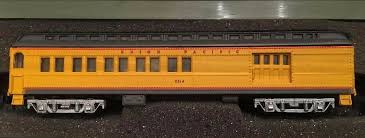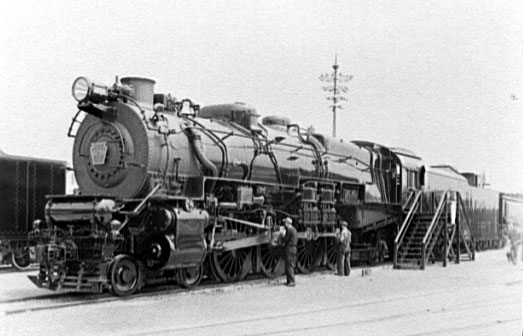Model Information: Bachmann introduced this model in 2007. They are fairly similar to the 4-8-2 Light Mountain model from 2003, but the heavy Mountain comes with a factory-installed decoder.
DCC Information: These models come with factory-installed DCC decoders.
Prototype History: Under the Whyte notation for the classification of steam locomotives, 4-8-2 represents the wheel arrangement of four leading wheels, eight powered and coupled driving wheels and two trailing wheels. This type of steam locomotive is commonly known as the Mountain type.
The 4-8-2 was most popular on the North American continent. When the 4-6-2 Pacific fleets were becoming over-burdened as passenger trains grew in length and weight, the first North American 4-8-2 locomotives were built by the American Locomotive Company (ALCO) for the Chesapeake and Ohio Railway (C&O) in 1911. It is possible that the "Mountain" name was originated by C&O, after the Allegheny Mountains where their first 4-8-2 locomotives were built to work. ALCO combined the traction of the eight-coupled 2-8-2 Mikado with the excellent tracking qualities of the Pacific's four-wheel leading truck. Although C&O intended their new Mountains for passenger service, the type also proved ideal for the new, faster freight services that railroads in the United States were introducing. Many 4-8-2 locomotives were therefore built for dual service.
The New York Central Railroad (NYC) called the 4-8-2 type of steam locomotive the Mohawk type. It was known as the Mountain type on other roads, but the mighty New York Central didn't see the name to be fitting on its famous Water Level Route, so it instead picked the name of one of those rivers its rails followed, the Mohawk River, to name its newest type of locomotive. Despite the more common name, the 4-8-2 was actually suited in many ways more to flatland running than slow mountain slogging, with its 4-wheel leading truck for stability at speed.
From Wikipedia
The 4-8-2 was most popular on the North American continent. When the 4-6-2 Pacific fleets were becoming over-burdened as passenger trains grew in length and weight, the first North American 4-8-2 locomotives were built by the American Locomotive Company (ALCO) for the Chesapeake and Ohio Railway (C&O) in 1911. It is possible that the "Mountain" name was originated by C&O, after the Allegheny Mountains where their first 4-8-2 locomotives were built to work. ALCO combined the traction of the eight-coupled 2-8-2 Mikado with the excellent tracking qualities of the Pacific's four-wheel leading truck. Although C&O intended their new Mountains for passenger service, the type also proved ideal for the new, faster freight services that railroads in the United States were introducing. Many 4-8-2 locomotives were therefore built for dual service.
The New York Central Railroad (NYC) called the 4-8-2 type of steam locomotive the Mohawk type. It was known as the Mountain type on other roads, but the mighty New York Central didn't see the name to be fitting on its famous Water Level Route, so it instead picked the name of one of those rivers its rails followed, the Mohawk River, to name its newest type of locomotive. Despite the more common name, the 4-8-2 was actually suited in many ways more to flatland running than slow mountain slogging, with its 4-wheel leading truck for stability at speed.
From Wikipedia
Road Name History: The Denver & Rio Grande Western Railroad (reporting mark DRGW), often shortened to Rio Grande, D&RG or D&RGW, formerly the Denver & Rio Grande Railroad, was an American Class I railroad company. The railroad started as a 3 ft (914 mm) narrow gauge line running south from Denver, Colorado in 1870. It served mainly as a transcontinental bridge line between Denver, and Salt Lake City, Utah.
In 1988, the Rio Grande's parent corporation, Rio Grande Industries, purchased Southern Pacific Transportation Company, and as the result of a merger, the larger Southern Pacific Railroad name was chosen for identity. The Rio Grande operated as a separate division of the Southern Pacific, until that company was acquired by the Union Pacific Railroad. Today, most former D&RGW main lines are owned and operated by the Union Pacific while several branch lines are now operated as heritage railways by various companies.
In 1988, the Rio Grande's parent corporation, Rio Grande Industries, purchased Southern Pacific Transportation Company, and as the result of a merger, the larger Southern Pacific Railroad name was chosen for identity. The Rio Grande operated as a separate division of the Southern Pacific, until that company was acquired by the Union Pacific Railroad. Today, most former D&RGW main lines are owned and operated by the Union Pacific while several branch lines are now operated as heritage railways by various companies.
Brand/Importer Information: Bachmann Industries (Bachmann Brothers, Inc.) is a Bermuda registered Chinese owned company, globally headquartered in Hong Kong; specializing in model railroading.
Founded in Philadelphia, Pennsylvania, the home of its North American headquarters, Bachmann is today part of the Kader group, who model products are made at a Chinese Government joint-venture plant in Dongguan, China. Bachmann's brand is the largest seller, in terms of volume, of model trains in the world. Bachmann primarily specializes in entry level train sets, and premium offerings in many scales. The Spectrum line is the high quality, model railroad product line, offered in N, HO, Large Scale, On30, and Williams O gauge all aimed for the hobbyist market. Bachmann is the producer of the famous railroad village product line known as "Plasticville." The turnover for Bachmann model trains for the year ended 31 December 2006 was approximately $46.87 million, a slight increase of 3.36% as compared to 2005.
Founded in Philadelphia, Pennsylvania, the home of its North American headquarters, Bachmann is today part of the Kader group, who model products are made at a Chinese Government joint-venture plant in Dongguan, China. Bachmann's brand is the largest seller, in terms of volume, of model trains in the world. Bachmann primarily specializes in entry level train sets, and premium offerings in many scales. The Spectrum line is the high quality, model railroad product line, offered in N, HO, Large Scale, On30, and Williams O gauge all aimed for the hobbyist market. Bachmann is the producer of the famous railroad village product line known as "Plasticville." The turnover for Bachmann model trains for the year ended 31 December 2006 was approximately $46.87 million, a slight increase of 3.36% as compared to 2005.
Item created by: gdm on 2017-09-30 18:44:10
If you see errors or missing data in this entry, please feel free to log in and edit it. Anyone with a Gmail account can log in instantly.
If you see errors or missing data in this entry, please feel free to log in and edit it. Anyone with a Gmail account can log in instantly.












